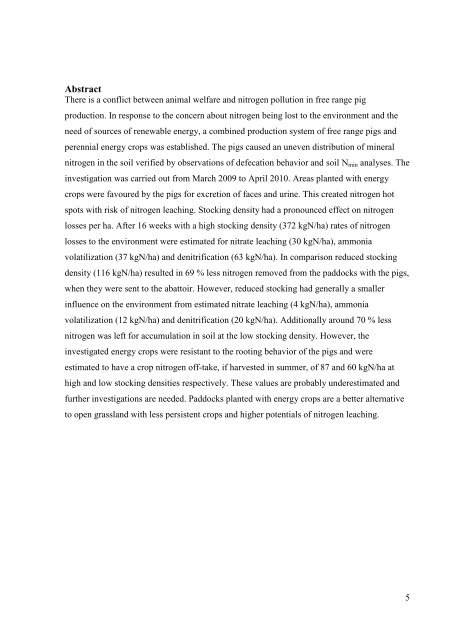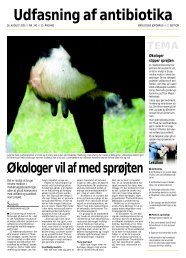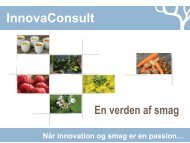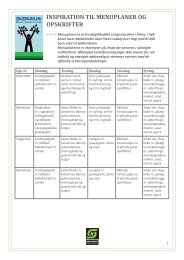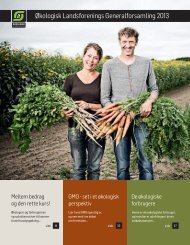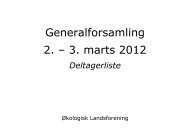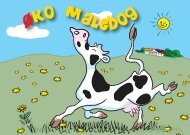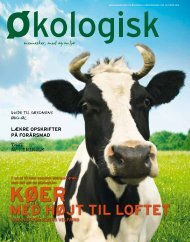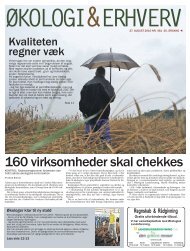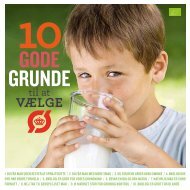Nitrogen distribution and potential nitrate leaching in a combined ...
Nitrogen distribution and potential nitrate leaching in a combined ...
Nitrogen distribution and potential nitrate leaching in a combined ...
Create successful ePaper yourself
Turn your PDF publications into a flip-book with our unique Google optimized e-Paper software.
Abstract<br />
There is a conflict between animal welfare <strong>and</strong> nitrogen pollution <strong>in</strong> free range pig<br />
production. In response to the concern about nitrogen be<strong>in</strong>g lost to the environment <strong>and</strong> the<br />
need of sources of renewable energy, a comb<strong>in</strong>ed production system of free range pigs <strong>and</strong><br />
perennial energy crops was established. The pigs caused an uneven <strong>distribution</strong> of m<strong>in</strong>eral<br />
nitrogen <strong>in</strong> the soil verified by observations of defecation behavior <strong>and</strong> soil Nm<strong>in</strong> analyses. The<br />
<strong>in</strong>vestigation was carried out from March 2009 to April 2010. Areas planted with energy<br />
crops were favoured by the pigs for excretion of faces <strong>and</strong> ur<strong>in</strong>e. This created nitrogen hot<br />
spots with risk of nitrogen <strong>leach<strong>in</strong>g</strong>. Stock<strong>in</strong>g density had a pronounced effect on nitrogen<br />
losses per ha. After 16 weeks with a high stock<strong>in</strong>g density (372 kgN/ha) rates of nitrogen<br />
losses to the environment were estimated for <strong>nitrate</strong> <strong>leach<strong>in</strong>g</strong> (30 kgN/ha), ammonia<br />
volatilization (37 kgN/ha) <strong>and</strong> denitrification (63 kgN/ha). In comparison reduced stock<strong>in</strong>g<br />
density (116 kgN/ha) resulted <strong>in</strong> 69 % less nitrogen removed from the paddocks with the pigs,<br />
when they were sent to the abattoir. However, reduced stock<strong>in</strong>g had generally a smaller<br />
<strong>in</strong>fluence on the environment from estimated <strong>nitrate</strong> <strong>leach<strong>in</strong>g</strong> (4 kgN/ha), ammonia<br />
volatilization (12 kgN/ha) <strong>and</strong> denitrification (20 kgN/ha). Additionally around 70 % less<br />
nitrogen was left for accumulation <strong>in</strong> soil at the low stock<strong>in</strong>g density. However, the<br />
<strong>in</strong>vestigated energy crops were resistant to the root<strong>in</strong>g behavior of the pigs <strong>and</strong> were<br />
estimated to have a crop nitrogen off-take, if harvested <strong>in</strong> summer, of 87 <strong>and</strong> 60 kgN/ha at<br />
high <strong>and</strong> low stock<strong>in</strong>g densities respectively. These values are probably underestimated <strong>and</strong><br />
further <strong>in</strong>vestigations are needed. Paddocks planted with energy crops are a better alternative<br />
to open grassl<strong>and</strong> with less persistent crops <strong>and</strong> higher <strong>potential</strong>s of nitrogen <strong>leach<strong>in</strong>g</strong>.<br />
5


